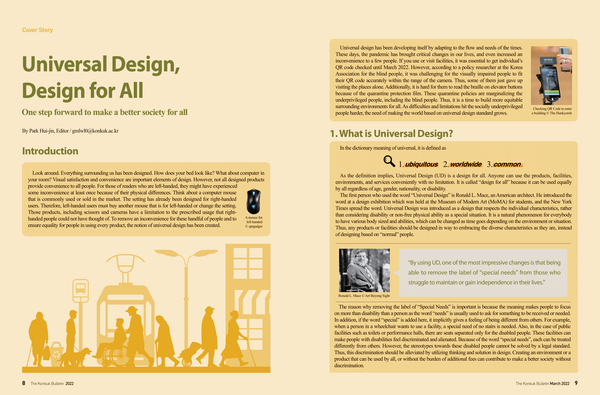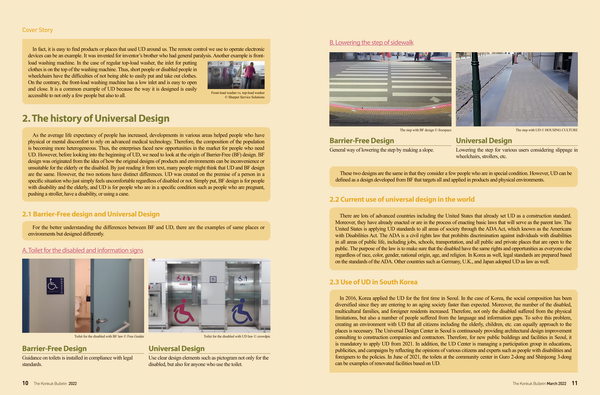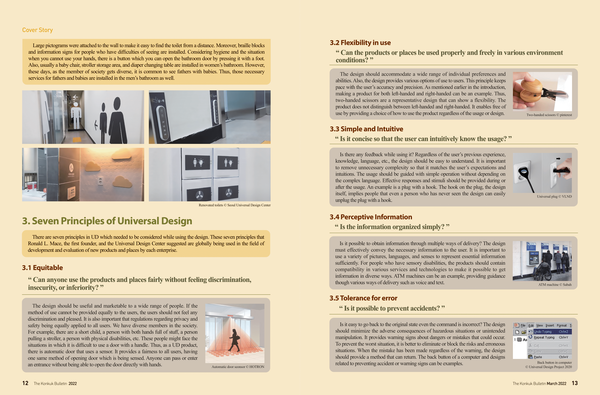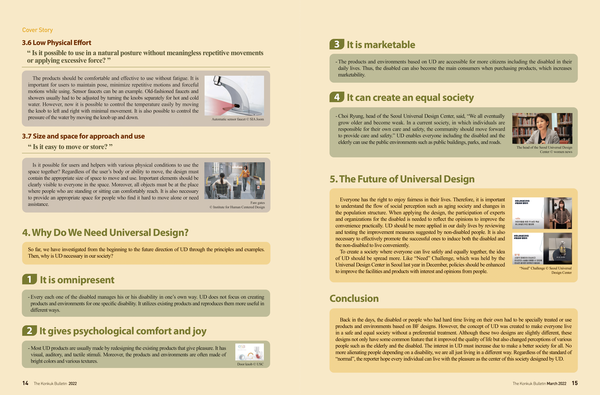One step forward to make a better society for all




Introduction
Look around. Everything surrounding us has been designed. How does your bed look like? What about computer in your room? Visual satisfaction and convenience are important elements of design. However, not all designed products provide convenience to all people. For those of readers who are left-handed, they might have experienced some inconvenience at least once because of their physical differences. Think about a computer mouse that is commonly used or sold in the market. The setting has already been designed for right-handed users. Therefore, left-handed users must buy another mouse that is for left-handed or change the setting. Those products, including scissors and cameras have a limitation to the prescribed usage that righthanded people could not have thought of. To remove an inconvenience for these handful of people and to ensure equality for people in using every product, the notion of universal design has been created.
Universal design has been developing itself by adapting to the flow and needs of the times. These days, the pandemic has brought critical changes in our lives, and even increased an inconvenience to a few people. If you use or visit facilities, it was essential to get individual’s QR code checked until March 2022. However, according to a policy researcher at the Korea Association for the blind people, it was challenging for the visually impaired people to fit their QR code accurately within the range of the camera. Thus, some of them just gave up visiting the places alone. Additionally, it is hard for them to read the braille on elevator buttons because of the quarantine protection film. These quarantine policies are marginalizing the underprivileged people, including the blind people. Thus, it is a time to build more equitable surrounding environments for all. As difficulties and limitations hit the socially underprivileged people harder, the need of making the world based on universal design standard grows.
1. What is Universal Design?
In the dictionary meaning of universal, it is defined as
1. ubiquitous 2. worldwide 3. common
As the definition implies, Universal Design (UD) is a design for all. Anyone can use the products, facilities, environments, and services conveniently with no limitation. It is called “design for all” because it can be used equally by all regardless of age, gender, nationality, or disability.
The first person who used the word “Universal Design” is Ronald L. Mace, an American architect. He introduced the word at a design exhibition which was held at the Museum of Modern Art (MoMA) for students, and the New York Times spread the word. Universal Design was introduced as a design that respects the individual characteristics, rather than considering disability or non-free physical ability as a special situation. It is a natural phenomenon for everybody to have various body sized and abilities, which can be changed as time goes depending on the environment or situation. Thus, any products or facilities should be designed in way to embracing the diverse characteristics as they are, instead of designing based on “normal” people.
“By using UD, one of the most impressive changes is that being
able to remove the label of “special needs” from those who
struggle to maintain or gain independence in their lives.”
- Ronald L. Mace
The reason why removing the label of “Special Needs” is important is because the meaning makes people to focus on more than disability than a person as the word “needs” is uusally used to ask for something to be received or needed. In addition, if the word “special” is added here, it implicitly gives a feeling of being different from others. For example, when a person in a wheelchair wants to use a facility, a special need of no stairs is needed. Also, in the case of public facilities such as toilets or performance halls, there are seats separated only for the disabled people. These facilities can make people with disabilities feel discriminated and alienated. Because of the word “special needs”, each can be treated differently from others. However, the stereotypes towards these disabled people cannot be solved by a legal standard. Thus, this discrimination should be alleviated by utilizing thinking and solution in design. Creating an environment or a product that can be used by all, or without the burden of additional fees can contribute to make a better society without discrimination.
In fact, it is easy to find products or places that used UD around us. The remote control we use to operate electronic devices can be an example. It was invented for inventor’s brother who had general paralysis. Another example is frontload washing machine. In the case of regular top-load washer, the inlet for putting clothes is on the top of the washing machine. Thus, short people or disabled people in wheelchairs have the difficulties of not being able to easily put and take out clothes. On the contrary, the front-load washing machine has a low inlet and is easy to open and close. It is a common example of UD because the way it is designed is easily accessible to not only a few people but also to all.
2. The history of Universal Design
As the average life expectancy of people has increased, developments in various areas helped people who have physical or mental discomfort to rely on advanced medical technology. Therefore, the composition of the population is becoming more heterogeneous. Thus, the enterprises faced new opportunities in the market for people who need UD. However, before looking into the beginning of UD, we need to look at the origin of Barrier-Free (BF) design. BF design was originated from the idea of how the original designs of products and environments can be inconvenience or unsuitable for the elderly or the disabled. By just reading it from text, many people might think that UD and BF design are the same. However, the two notions have distinct differences. UD was created on the premise of a person in a specific situation who just simply feels uncomfortable regardless of disabled or not. Simply put, BF design is for people with disability and the elderly, and UD is for people who are in a specific condition such as people who are pregnant, pushing a stroller, have a disability, or using a cane.
2.1 Barrier-Free design and Universal Design
For the better understanding the differences between BF and UD, there are the examples of same places or environments but designed differently.
A. Toilet for the disabled and information signs
Barrier-Free Design
Guidance on toilets is installed in compliance with legal standards.
Universal Design
Use clear design elements such as pictogram not only for the disabled, but also for anyone who use the toilet.
B. Lowering the step of sidewalk
Barrier-Free Design
General way of lowering the step by making a slope.
Universal Design
Lowering the step for various users considering slippage in wheelchairs, strollers, etc.
These two designs are the same in that they consider a few people who are in special condition. However, UD can be defined as a design developed from BF that targets all and applied in products and physical environments.
2.2 Current use of universal design in the world
There are lots of advanced countries including the United States that already set UD as a construction standard. Moreover, they have already enacted or are in the process of enacting basic laws that will serve as the parent law. The United States is applying UD standards to all areas of society through the ADA Act, which known as the Americans with Disabilities Act. The ADA is a civil rights law that prohibits discrimination against individuals with disabilities in all areas of public life, including jobs, schools, transportation, and all public and private places that are open to the public. The purpose of the law is to make sure that the disabled have the same rights and opportunities as everyone else regardless of race, color, gender, national origin, age, and religion. In Korea as well, legal standards are prepared based on the standards of the ADA. Other countries such as Germany, U.K., and Japan adopted UD as law as well.
2.3 Use of UD in South Korea
In 2016, Korea applied the UD for the first time in Seoul. In the case of Korea, the social composition has been diversified since they are entering to an aging society faster than expected. Moreover, the number of the disabled, multicultural families, and foreigner residents increased. Therefore, not only the disabled suffered from the physical limitations, but also a number of people suffered from the language and information gaps. To solve this problem, creating an environment with UD that all citizens including the elderly, children, etc. can equally approach to the places is necessary. The Universal Design Center in Seoul is continuously providing architectural design improvement consulting to construction companies and contractors. Therefore, for new public buildings and facilities in Seoul, it is mandatory to apply UD from 2021. In addition, the UD Center is managing a participation group in educations, publicities, and campaigns by reflecting the opinions of various citizens and experts such as people with disabilities and foreigners to the policies. In June of 2021, the toilets at the community center in Guro 2-dong and Shinjeong 3-dong can be examples of renovated facilities based on UD.
Large pictograms were attached to the wall to make it easy to find the toilet from a distance. Moreover, braille blocks and information signs for people who have difficulties of seeing are installed. Considering hygiene and the situation when you cannot use your hands, there is a button which you can open the bathroom door by pressing it with a foot. Also, usually a baby chair, stroller storage area, and diaper changing table are installed in women’s bathroom. However, these days, as the member of society gets diverse, it is common to see fathers with babies. Thus, those necessary services for fathers and babies are installed in the mens’ bathroom as well.
3. Seven Principles of Universal Design
There are seven principles in UD which needed to be considered while using the design. These seven principles that Ronald L. Mace, the first founder, and the Universal Design Center suggested are globally being used in the field of development and evaluation of new products and places by each enterprise.
3.1 Equitable
“ Can anyone use the products and places fairly without feeling discrimination, insecurity, or inferiority? ”
The design should be useful and marketable to a wide range of people. If the method of use cannot be provided equally to the users, the users should not feel any discrimination and pleased. It is also important that regulations regarding privacy and safety being equally applied to all users. We have diverse members in the society. For example, there are a short child, a person with both hands full of stuff, a person pulling a stroller, a person with physical disabilities, etc. These people might face the situations in which it is difficult to use a door with a handle. Thus, as a UD product, there is automatic door that uses a sensor. It provides a fairness to all users, having one same method of opening door which is being sensed. Anyone can pass or enter an entrance without being able to open the door directly with hands. field of development and evaluation of new products and places by each enterprise.
3.2 Flexibility in use
“ Can the products or places be used properly and freely in various environment conditions? ”
The design should accommodate a wide range of individual preferences and abilities. Also, the design provides various options of use to users.T his principle keeps pace with the user’s accuracy and precision. As mentioned earlier in the introduction, making a product for both left-handed and right-handed can be an example. Thus, two-handed scissors are a representative design that can show a flexibility. The product does not distinguish between left-handed and right-handed. It enables free of use by providing a choice of how to use the product regardlesso f the usage or design.
3.3 Simple and Intuitive
“ Is it concise so that the user can intuitively know the usage? ”
Is there any feedback while using it? Regardless of the user’s previous experience, knowledge, language, etc., the design should be easy to understand. It is important to remove unnecessary complexity so that it matches the user’s expectations and intuitions. The usage should be guided with simple operation without depending on the complex language. Effective responses and stimuli should be provided during or after the usage. An example is a plug with a hook. The hook on the plug, the design itself, implies people that even a person who has never seen the design can easily unplug the plug with a hook.
3.4 Perceptive Information
“ Is the information organized simply? ”
Is it possible to obtain information through multiple ways of delivery? The design must effectively convey the necessary information to the user. It is important to use a variety of pictures, languages, and senses to represent essential information sufficiently. For people who have sensory disabilities, the products should contain compatibility in various services and technologies to make it possible to get information in diverse ways. ATM machines can be an example, providing guidance though various ways of delivery such as voice and text.
3.5 Tolerance for error
“ Is it possible to prevent accidents? ”
Is it easy to go back to the original state even the command is incorrect? The design should minimize the adverse consequences of hazardous situations or unintended manipulation. It provides warning signs about dangers or mistakes that could occur. To prevent the worst situation, it is better to eliminate or block the risks and erroneous situations. When the mistake has been made regardless of the warning, the design should provide a method that can return. The back button of a computer and designs related to preventing accident or warning signs can be examples.
3.6 Low Physical Effort
“ Is it possible to use in a natural posture without meaningless repetitive movements or applying excessive force? ”
The products should be comfortable and effective to use without fatigue. It is important for users to maintain pose, minimize repetitive motions and forceful motions while using. Sensor faucets can be an example. Old-fashioned faucets and showers usually had to be adjusted by turning the knobs separately for hot and cold water. However, now it is possible to control the temperature easily by moving the knob to left and right with minimal movement. It is also possible to control the pressure of the water by moving the knob up and down.
3.7 Size and space for approach and use
“ Is it easy to move or store? ”
Is it possible for users and helpers with various physical conditions to use the space together? Regardless of the user’s body or ability to move, the design must contain the appropriate size of space to move and use. Important elements should be clearly visible to everyone in the space. Moreover, all objects must be at the place where people who are standing or sitting can comfortably reach. It is also necessary to provide an appropriate space for people who find it hard to move alone or need assistance.
4. Why Do We Need Universal Design?
So far, we have investigated from the beginning to the future direction of UD through the principles and examples. Then, why is UD necessary in our society?
1) It is omnipresent
Every each one of the disabled manages his or his disability in one’s own way. UD does not focus on creating products and environments for one specific disability. It utilizes existing products and reproduces them more useful in different ways.
2) It gives psychological comfort and joy
Most UD products are usually made by redesigning the existing products that give pleasure. It has visual, auditory, and tactile stimuli. Moreover, the products and environments are often made of bright colors and various textures.
3) It is marketable
The products and environments based on UD are accessible for more citizens including the disabled in their daily lives. Thus, the disabled can also become the main consumers when purchasing products, which increases marketability.
4) It can create an equal society
Choi Ryung, head of the Seoul Universal Design Center, said, “We all eventually grow older and become weak. In a current society, in which individuals are responsible for their own care and safety, the community should move forward to provide care and safety.” UD enables everyone including the disabled and the elderly can use the public environments such as public buildings, parks, and roads.
5. The Future of Universal Design
Everyone has the right to enjoy fairness in their lives. Therefore, it is important to understand the flow of social perception such as aging society and changes in the population structure. When applying the design, the participation of experts and organizations for the disabled is needed to reflect the opinions to improve the convenience practically. UD should be more applied in our daily lives by reviewing and testing the improvement measures suggested by non-disabled people. It is also necessary to effectively promote the successful ones to induce both the disabled and the non-disabled to live conveniently.
To create a society where everyone can live safely and equally together, the idea of UD should be spread more. Like “Need” Challenge, which was held by the Universal Design Center in Seoul last year in December, policies should be enhanced to improve the facilities and products with interest and opinions from people.
Conclusion
Back in the days, the disabled or people who had hard time living on their own had to be specially treated or use products and environments based on BF designs. However, the concept of UD was created to make everyone live in a safe and equal society without a preferential treatment. Although these two designs are slightly different, these designs not only have some common feature that it improved the quality of life but also changed perceptions of various people such as the elderly and the disabled. The interest in UD must increase due to make a better society for all. No more alienating people depending on a disability, we are all just living in a different way. Regardless of the standard of “normal”, the reporter hope every individual can live with thep leasure as the center of this society designed by UD.

